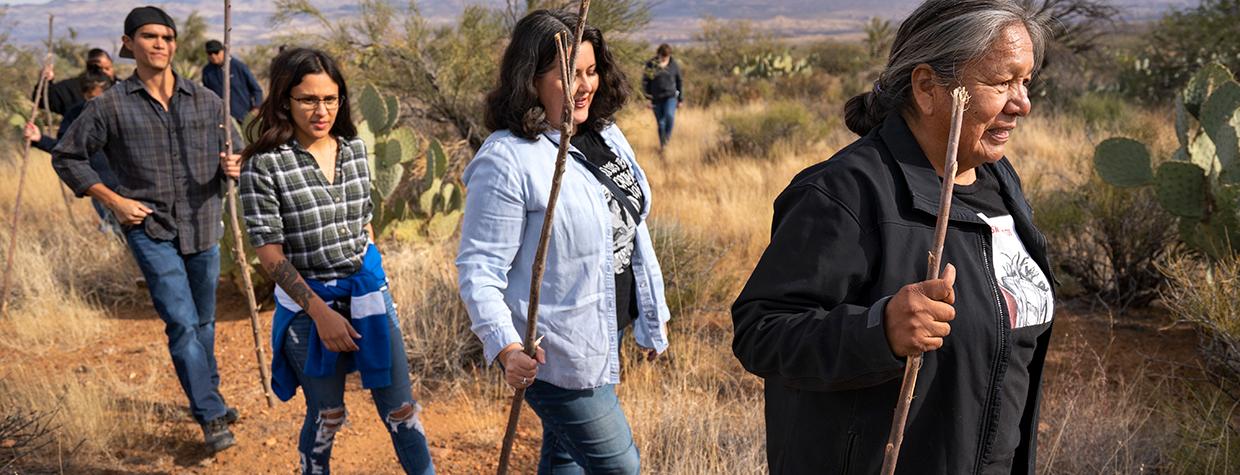Like many 13-year-old girls, Margie Bendle is fond of crafts. She likes to make bracelets and anklets out of string. She also enjoys playing basketball. And she prefers math over English.
And there’s something else Margie likes to do: hunt gloscho, the Apache name for the desert woodrat (Neotoma lepida). The small mammal was a food staple for Margie’s Western Apache ancestors before they were exiled from their sprawling homeland in the mid-19th century and confined to the San Carlos Reservation.
Last November, Margie joined her aunt Twila Cassadore and other San Carlos and White Mountain Apaches on a gloscho hunt. Like many aspects of traditional Apache foodways, hunting and eating gloscho has faded from tribal life during the past century as processed foods have taken the place of traditional ones. But Cassadore and other Apaches are on a mission to help fellow tribal members learn the ancient hunting and foraging traditions of their ancestors. They’re convinced that traversing their homeland and gathering their traditional foods is the best medicine for healing the physical, emotional and spiritual ills that now plague the Apache people.
“Western doctors try to tell us that they know what is best for us, but they actually don’t know,” says Cassadore, who leads gloscho hunts and other foraging outings as part of the San Carlos tribe’s Traditional Western Apache Diet Project. “We all have to deal with the same trauma of colonization. Foraging is very therapeutic for everyone I have taken out.”
More than a dozen San Carlos and White Mountain Apaches participated in the November gloscho hunt. Along with Cassadore and Margie, tribal members working for the San Carlos Language Preservation Program and the tribe’s Wellness Center participated. There also were San Carlos and White Mountain Apaches who were residents at a substance abuse recovery center in Mesa and made the trip to tribal land for some authentic healing.
With each participant holding a javelin-like stick made from salt cedar, the group wandered across the high-desert landscape, taking cues from Cassadore on where to find the woodrats. In pre-reservation times, the rodents were an important source of protein during the winter months, when seasonal plant staples were sparse.
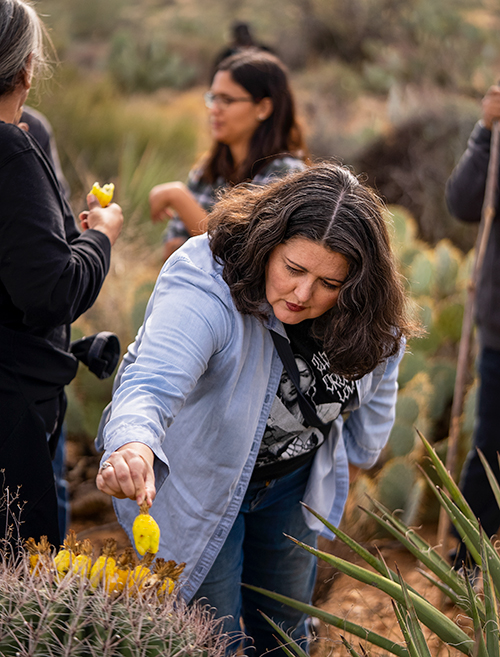
As the group walked among creosotes, agaves, ocotillos and prickly pear cactuses, Cassadore instructed them on how to recognize a woodrat nest. Once they found a nest, often at the base of a large prickly pear, the hunters were told to spear the hole, prompting the woodrats to run out and meet their fate at the end of the stick. Cassadore also pointed out edible plants that were central to the traditional diet, such as bright yellow barrel cactus fruit, agave stalks and red sumac berries.
“I was scared at first, but I slowly got used to it,” Margie said later, as she reflected on the gloscho hunt. “And then I absolutely loved it. I liked how we were all out there doing it together.”
Wandering across the desert beneath a pale blue sky, the hunters were laughing and joyful. And perhaps they also realized they were making history.
For Shane Burnette, a White Mountain Apache who manages the Mesa recovery center that participated in the gloscho hunt, taking his Indigenous clients on foraging outings has proved to be an exceptionally effective form of treatment. “In today’s world, the Apache are still fighting for survival,” he says, “but it’s not with bows and arrows. Our war is on the tabletop, against all the malnourishment we experience living in a ‘food desert.’ ”
When his clients venture out to hunt woodrats or gather traditional plants, Burnette says, it opens their eyes to a different way of being — one that’s deeply rooted to the Earth, the seasons and their ancestors. “We learn we have everything that we need right outside,” he says. “But it requires reconnecting with the plants. That is why the plants come back to us every year. They are crying out for us to use them.”
Before European colonizers arrived in the Southwest, the Western Apache homeland encompassed more than 11 million acres, occupying what today is all of Eastern Arizona from the Mexican border up to the central part of the state. Unlike agricultural tribes, such as the Hopi and Pima peoples, the Western Apaches were widely dispersed, often with clans living hundreds of miles apart. These groups traveled according to a seasonal cycle as they foraged for the plants that made up their diet. The harvesting and preparation of these plants was the basis of Apache ceremonies and central to daily life. Knowledge about what to eat and where to find it was passed seamlessly from one generation to the next, as was a spiritual perspective intimately tied to their environment.
The Apaches gathered saguaro fruit in the Sonoran Desert, Emory oak acorns in the mountains and seeds in the grasslands as they foraged across an ecologically diverse homeland that ranged from 2,000 to 10,000 feet in elevation. It was a highly nutritious diet, as evidenced by the fact that Apache warriors were notorious for outpacing American cavalry whose horses couldn’t match the Apaches’ ability to run more than
70 miles in a single day.
But Western Apache life, along with their diet, changed abruptly in the 1870s, when the U.S. government ordered all Western Apaches “concentrated” on a small patch of desert in Southeastern Arizona called Camp San Carlos. Any Apache found outside the boundaries of the camp, which was nicknamed “Hell’s 40 Acres,” was to be shot on sight. And rather than being allowed to forage and hunt, the male head of each Apache household was issued a tag number and required to report for weekly roll call to receive food rations. Tribal members who had nourished their bodies and spirits with the diverse flora and fauna of their homeland suddenly found themselves trying to survive on non-nutritious staples such as flour, sugar, lard, coffee and occasional cans of beef.
Western Apache groups were eventually allowed to leave Camp San Carlos and go back to their traditional lands, where reservations were established. Today’s San Carlos Apache, White Mountain Apache, Tonto Apache and Yavapai-Apache nations are inhabited by descendants from Hell’s 40 Acres. But the four tribal lands encompassed only a fraction of the Apaches’ historical hunting and foraging grounds, making it nearly impossible to adhere to the traditional Apache diet. Meanwhile, the U.S. government continued to dole out mass-produced rations. By the mid-20th century, most Western Apaches were no longer dependent on them, but those ingredients remained a central part of their diet through cheap processed foods and soda purchased at the grocery store and fast-food restaurants.
“The deterioration of our health and welfare started at Camp San Carlos,” says Steve Titla, an attorney and San Carlos Apache Tribe member. Titla, 67, has lived on tribal land all his life and is chairman of the San Carlos Apache Healthcare Corp., which runs the tribe’s hospital. “Before being subjugated by the cavalry,” he says, “we ate well, were physically and spiritually strong, and we had very little stress.”
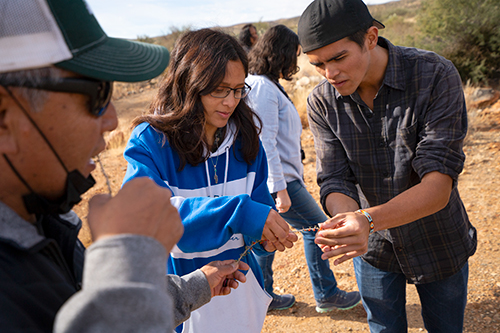
Today, Titla says, the San Carlos people, along with the other Western Apache tribes, suffer from an “epidemic” of diabetes, heart disease and cancer. “It has a lot to do with a lack of physical activity and eating processed foods with high carbs, fats and sugar,” he adds.
According to the federal Indian Health Service, more than 26 percent of children ages 2 to 5 on the San Carlos tribe’s land were diagnosed as obese in 2018. That year, the second-leading cause of death for adults there was alcohol-related liver disease, the No. 12 cause of death for the overall U.S. population. And there are also deeply entrenched problems with suicide, the fifth-leading cause of death on the tribe’s land — and something that was extremely rare in pre-reservation times.
Twenty years ago, when staff members at the tribe’s Forest Resources Program were interviewing tribal elders about native plants, the elders suggested that if people could be convinced to eat the traditional Western Apache diet, the “new sicknesses” would disappear. But what was the traditional diet, exactly? There was no written record. And after 150 years, detailed knowledge about foraging and preparing traditional foods was being lost as the elders died.
In an effort to preserve this information, tribal staff spent years interviewing elders born between 1900 and 1930. These Apaches had learned traditional foodways from their grandparents, who had grown up before the reservation. Their input was methodically entered into a database that identified more than 100 wild plant species, along with 50 species of mammals and birds, that were part of the Apache diet. The compilation would reveal that wild plants constituted 40 to 60 percent of the diet and wild meat made up 20 to 40 percent, with agricultural plants such as corn and squash filling in the gaps.
Around 2015, staff at the Traditional Western Apache Diet Project used hundreds of elder interviews and other research to compile nearly 100 daily pre-reservation menus, then worked with a consultant to create a nutritional analysis of the diet based on those menus. The results were about as far as one could get from a Big Mac, fries and a Coke. The diet contains double the daily fiber and protein recommended by the U.S. Department of Agriculture. It’s also low in sodium, cholesterol and unhealthy fats while being high in vitamins B, C and K, as well as calcium, zinc, iron and healthy fats. In short, it’s a diet that supports distance running, an ideal fit for the traditional Apache running culture.
While tribal health professionals are happy to learn about the nutrition and medicinal potential that could come with a transition to the traditional diet, the tribe’s staff members say some San Carlos Apaches have been more interested in what that transition represents: a chance to connect to the natural world and experience the life of a traditional Apache.
The White Mountain Apache Tribe’s Rainbow Treatment Center is using what it calls “nutritional recovery,” revitalizing knowledge of Indigenous foods, to help its clients heal from alcohol and drug addiction. The center highlights the traditional Western Apache diet as a key element to staying clean, both in terms of substance abuse and when it comes to preventing and managing health problems caused by processed foods, soda and other convenience items.
“There are so many social ills and obstacles to food access that we are dealing with in our community,” says Nephi Craig, the center’s Nutritional Recovery Program coordinator. “Good food and nourishment is part of a person’s support system in sobriety.”
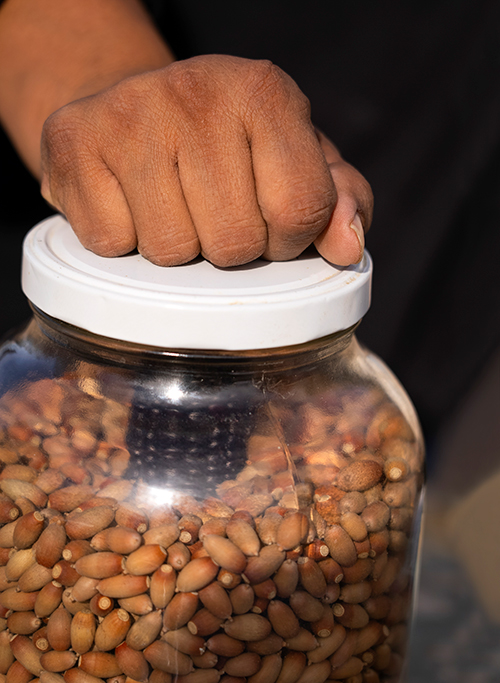
Craig speaks from experience. He’s been sober since 2011, and he attributes his recovery to returning to his cultural roots and focusing on the “transformational power” of native foods. Craig, 42, is also a classically trained gourmet chef who’s worked at five-star restaurants at Phoenix-area resorts.
In October 2021, the Rainbow Treatment Center opened Café Gozhóó in the tribal community of Whiteriver. Gozhóó is an Apache word that means a variety of positive things: harmony, happiness, balance, beauty, love and respect. And Craig is the head chef.
Located in a converted gas station, the restaurant has a kitchen built to Craig’s specifications and is staffed by full-time employees and clients of the treatment center. It’s a point of pride for the community, offering tribal members the rare opportunity to enjoy affordable, healthy food cooked by a gourmet chef who’s one of their own. Craig often creates specials that incorporate traditional Apache ingredients such as Emory oak acorns, sunflower seeds and prickly pear fruit. “We want the café to stimulate a web of wellness in our community,”
he says.
Like Craig, Twila Cassadore found her path to sobriety through reconnecting with her culture and traditional Apache foods. Cassadore, 55, says she was lost in early adulthood, battling addiction and cut off from her culture. But about 20 years ago, a group of elders took her to the Gila River to forage for basketmaking materials. It was the same stretch of river where she had been sexually abused as a child. “The elders let me go off by myself, and when I was out there foraging, something happened to me,” she recalls. “I could hear the birds and feel the wind. Mother Earth hugged me and told me I am loved.”
She stopped drinking and started spending time on the land, gathering the plants and hunting the animals that nourished her ancestors. A native Apache speaker, Cassadore also joined the Traditional Western Apache Diet Project and began interviewing elders about her culture’s food history and traditions. She’s interviewed more than 100 so far.
“It was a healing process to be with the elders and get reconnected to traditional food,” she says. “When I was drinking, I was always trying to fill a void. Now, the void is filled with my culture and all the stories from the elders. You have no idea how happy I am.”
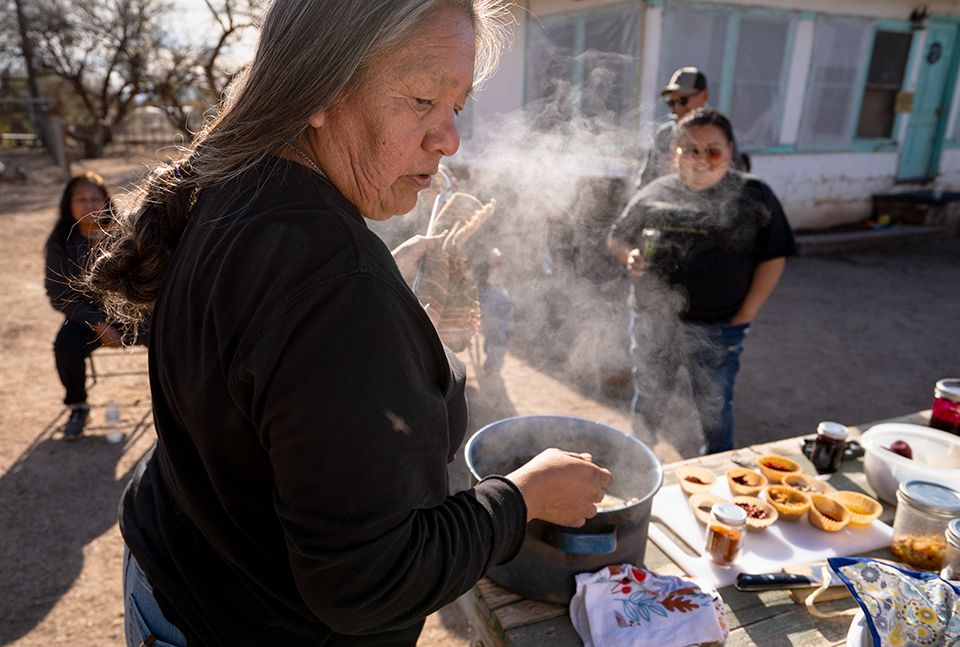
Cassadore has become a master forager who carries out the diet project’s educational aspects with a missionary’s zeal. She and other staff members teach tribal members how to incorporate traditional ingredients into their meals or use foods that are available at the grocery store and can serve as nutritional equivalents. But perhaps what excites tribal members most is participating in the food-related events that have been mostly absent from the community for more than a century. There now are agave roasts in the spring, acorn harvests in summer and gloscho hunts in fall and winter.
During the November gloscho hunt, Margie enjoyed watching the hunters but didn’t participate in the killing. In the afternoon, the group took several dead woodrats to a tribal member’s house for a barbecue. Cassadore demonstrated how to first boil the rodents and then grill them. Once they were cooked, she dusted the meat with a prickly pear sauce. She also put out other traditional foods for people to sample, such as agave stalks, sumac berries, barrel cactus seeds and prickly pear chips. “We are so empowered and we don’t even know it,” she says of her people’s ability to reclaim their culture and sovereignty.
But Margie knows it. She fully embraces her potential as an empowered Apache woman. Learning about traditional foods from Cassadore and participating in ceremonies has been a foundational part of her childhood. She proudly describes her September 2021 coming-of-age ceremony, an Apache tradition that celebrates a girl’s transition into womanhood. The multi-day ritual involves long periods of dancing, singing and running, and Margie also had to keep a fire burning all weekend.
“I am strong,” she says. “Eating healthy food makes me strong.”

